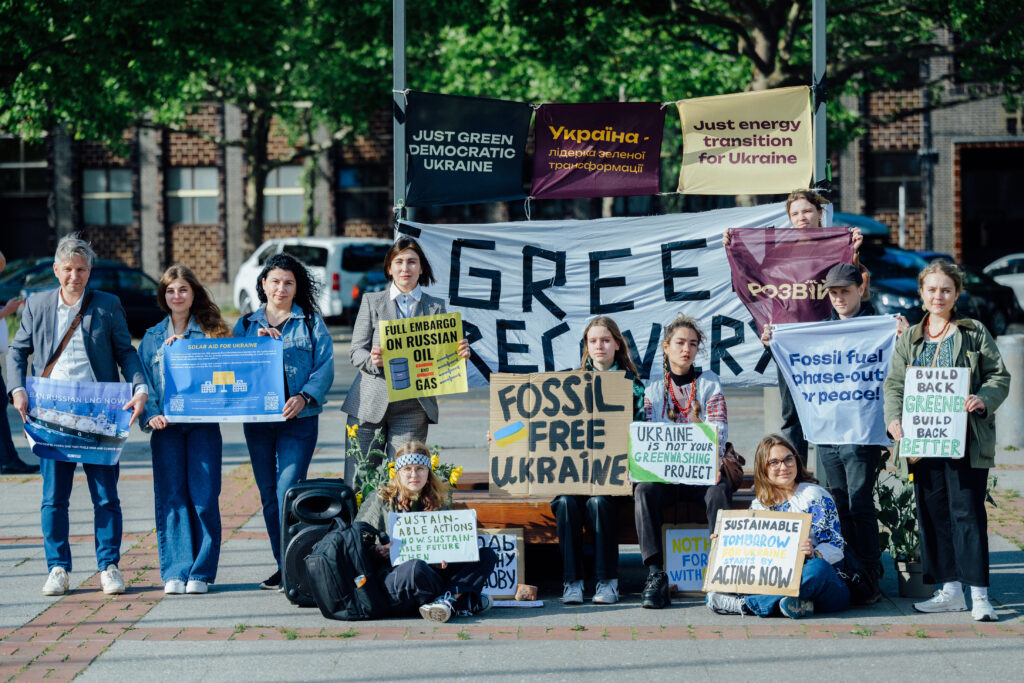Energy security is not only a burning global issue, but a cornerstone of Ukraine’s future, and the recent Ukraine Reconstruction Conference (URC) in Berlin offered a glimpse into the possibilities for a renewable-powered Ukraine that could lead the way for Europe’s green transition.

(Credit: Razom We Stand, All rights reserved.)
Why renewables matter more than ever, and why we need stronger sanctions
German Minister for Economic Affairs and Climate Action, Robert Habeck, rightly pointed out that renewable energy presents a compelling security advantage. Unlike a concentrated nuclear power plant, a vast network of solar panels offers a far less appealing target for attacks. This resonates deeply with the current situation in Ukraine, where centralized infrastructure has proven vulnerable to Russian aggression.
The URC, however, highlighted a concerning limitation. Due to Ukrainian mobilization laws and border restrictions, many of our own energy experts were unable to attend. Their absence limited crucial firsthand input on the colossal task of repairing Ukraine’s grid. Moving forward, ensuring inclusive participation in such discussions is vital, especially for those directly involved in the day-to-day challenges of rebuilding.
A decentralized, renewable future is our path forward, but we need full transparency
Russia’s relentless attacks have crippled Ukraine’s energy infrastructure. With a mere 9 GW of pre-war production capacity remaining – a staggering decline from 53 GW in 2021 – securing consistent electricity supplies for Ukrainian citizens remains a pressing challenge. This necessitates a radical shift towards a decentralized energy architecture powered by renewable sources like wind and solar, and distributed networks.
A multi-pronged approach is key to a rapid clean energy build-out:
- Distributed generation: Implementing solar panels and wind turbines at critical infrastructure facilities can significantly contribute to meeting peak summer demand and bolster preparedness for the upcoming heating season.
- Energy storage: Integrating battery storage systems can effectively bridge the gap between fluctuating renewable energy generation and consumption patterns.
- Microgrids: Establishing localized grids that integrate renewable energy sources and storage solutions can enhance energy independence at the community level.
These immediate solutions, coupled with medium-term plans for the rapid expansion of wind, solar, biomass and flexible gas generation capacities, necessitate an estimated investment of €10–13 billion over the next 2–3 years.
A vision: Ukraine, the renewable energy powerhouse
Ukraine’s long-term vision for its energy landscape is nothing short of inspiring – a large-scale renewable energy transition with the potential to harness a staggering 850 GW of renewable energy sources. This ambition is echoed in the National Energy and Climate Plan (NECP) target of achieving a 65% reduction in greenhouse gas emissions by 2030.
However, the NECP’s target of achieving a 27% renewable energy share by 2030 falls short of the European Union’s target of 42%. This gap undermines Ukraine’s potential to emerge as a global leader in the clean energy transition and attract the substantial green investments required for a significant leap in renewables adoption and climate action.
Unlocking Ukraine’s renewable energy potential – we need strong policies
To fully realize Ukraine’s potential as a renewable energy leader, several key actions are imperative:
- Market-based incentives: Implementing market instruments that incentivize investment in renewable energy sources is crucial for increasing their share in the overall energy mix.
- Investor confidence building: Addressing lingering investor concerns regarding policy stability and return on investment will be instrumental in attracting the necessary capital for a successful energy transition.
- EU Clean Energy Package adoption: Embracing the EU Clean Energy Package will establish a clear and predictable regulatory framework for investors, paving the way for Ukraine’s integration with the European energy market and fostering greater efficiency across the sector.
Standing together for a sustainable future – full transparency regarding sanctions is key
The estimated €40 billion required to implement the NECP by 2030 necessitates robust international partnerships. The global community must join forces in mobilizing these funds and supporting Ukraine’s transformation into a secure, self-sufficient nation powered by renewable energy. However, this effort must be coupled with full and transparent sanctions on all Russian fossil fuel exports by the EU and G7 countries. Russia’s continued ability to profit from its energy resources weakens sanctions and prolongs the war. By severing this lifeline, we can cripple Russia’s war machine and accelerate the day Ukraine can rebuild in peace.
By prioritizing renewable energy solutions, Ukraine can not only rebuild its war-torn infrastructure and ensure its energy security, but also emerge as a global leader in the clean energy transition, inspiring a future powered by sustainability and peace, for itself and the world.
The views and opinions in this article do not necessarily reflect those of the Heinrich-Böll-Stiftung European Union.